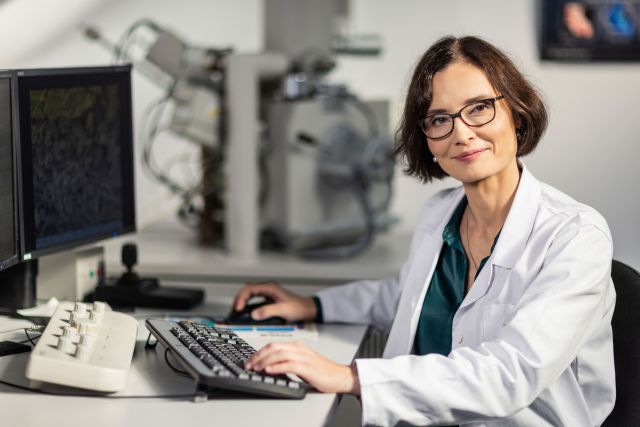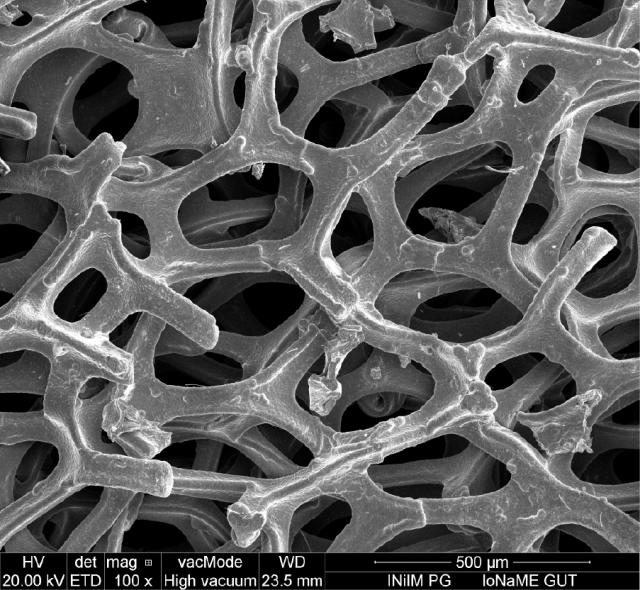Principal Investigator
:
Dr hab. inż. Beata Bochentyn
Gdańsk University of Technology
Panel: ST5
Funding scheme
: SONATA BIS 11
announced on
15 June 2021
The goal of the project is to understand and describe the formation of catalytically active nanoparticles on the grains of anode materials designed for solid oxide fuel cells (SOFCs) powered by eco-fuels (e.g. bioethanol, biogas, LPG). SOFCs are devices that convert chemical energy delivered by the fuel and the oxidizer directly into electrical energy. Since they can work practically anywhere as long as fuel is present, they are perfectly aligned with the concept of distributed energy generation (based on small units that produce energy for local use and from renewable energy sources). Unfortunately, commercial cells with a standard composite anode (cermet Ni-YSZ) are optimised for work with hydrogen fuel; the use of alternative fuels (such as eco-fuels) causes a range of problems, such as carbon deposition and anode poisoning by contaminants present in the fuel. It is thus necessary to search for new anode materials that would ensure long, stable operation under such conditions.
 Prof. Beata Bochentyn, photo by Michał Łepecki
Among recently investigated anode materials one can find compounds of perovskite structure, formed like minerals made up of non-organic chemical compounds, with a general formula of ABO3. Even though they seem like attractive candidates for SOFC anodes, their catalytic activity in terms of the electrochemical fuel oxidation process is low. In order to improve it, nanoparticles of metals, e.g. nickel or cobalt, may be deposited on the surface of perovskite grains. However, when nanoparticles are added “from the outside”, it is difficult to control their size and distribution; moreover, they tend to agglomerate under high temperatures, i.e. combine to form larger structures, which reduces their catalytic properties. This is the reason why researchers have recently turned their attention to the potential for obtaining in situ nanometric precipitates from perovskite structures through the process called exsolution. It occurs in reducing conditions and leads to the formation of uniformly distributed, small structures. Nanoparticles formed in this way are socketed in the substrate and less susceptible to agglomeration. Moreover, the possibility of creating multi-component alloys or intermetallic compounds additionally improves material parameters, when they are used as SOFC anodes. Such anodes show a higher catalytic activity, better resistance to carbon deposition and contamination with e.g. sulphur compounds.
Prof. Beata Bochentyn, photo by Michał Łepecki
Among recently investigated anode materials one can find compounds of perovskite structure, formed like minerals made up of non-organic chemical compounds, with a general formula of ABO3. Even though they seem like attractive candidates for SOFC anodes, their catalytic activity in terms of the electrochemical fuel oxidation process is low. In order to improve it, nanoparticles of metals, e.g. nickel or cobalt, may be deposited on the surface of perovskite grains. However, when nanoparticles are added “from the outside”, it is difficult to control their size and distribution; moreover, they tend to agglomerate under high temperatures, i.e. combine to form larger structures, which reduces their catalytic properties. This is the reason why researchers have recently turned their attention to the potential for obtaining in situ nanometric precipitates from perovskite structures through the process called exsolution. It occurs in reducing conditions and leads to the formation of uniformly distributed, small structures. Nanoparticles formed in this way are socketed in the substrate and less susceptible to agglomeration. Moreover, the possibility of creating multi-component alloys or intermetallic compounds additionally improves material parameters, when they are used as SOFC anodes. Such anodes show a higher catalytic activity, better resistance to carbon deposition and contamination with e.g. sulphur compounds.
 Prof. Beata Bochentyn, photo by Michał Łepecki
Our project focuses on an interesting method of forming multi-component nanoparticles: it aims to obtain alloys via the process of exsolution with topotactic ion exchange, during which the metal from the support crystal latice creates an alloy with the metal deposited on the surface. The materials obtained will undergo a range of structural, electrical and catalytic tests, before they are tested as anode materials for solid oxide fuel cells powered by eco-fuels. Alongside experimental studies, the project also relies on DFT calculations to determine the potential for the exsolution of nanoparticles and their alloys from a variety of selected structures, which will facilitate the design of new, catalytically active anodes for solid oxide fuel cells in the future.
Prof. Beata Bochentyn, photo by Michał Łepecki
Our project focuses on an interesting method of forming multi-component nanoparticles: it aims to obtain alloys via the process of exsolution with topotactic ion exchange, during which the metal from the support crystal latice creates an alloy with the metal deposited on the surface. The materials obtained will undergo a range of structural, electrical and catalytic tests, before they are tested as anode materials for solid oxide fuel cells powered by eco-fuels. Alongside experimental studies, the project also relies on DFT calculations to determine the potential for the exsolution of nanoparticles and their alloys from a variety of selected structures, which will facilitate the design of new, catalytically active anodes for solid oxide fuel cells in the future.
The project will fill a gap in our current knowledge on SOFCs powered by eco-fuels and potentially help find better, alternative anode materials to replace the current commercial models.
Project title: Tailoring multicomponent nanometric alloys formed on active support for designing the stable anodes of Solid Oxide Fuel Cells
Dr hab. inż. Beata Bochentyn
Born in 1985 in Wejherowo, she earned a PhD in physical sciences in 2013, followed by habilitation degree in 2020. She works as an Associate Professor at the Institute of Nanotechnology and Materials Science of the Gdańsk University of Technology, where she heads the Division of Novel Functional Materials for Energy Conversion. She is a winner of the START Scholarship awarded by the FNP (2017), the “Polityka” Science Awards programme (2021) and the W.H. Nernst Award for Scientific Achievement in Electrochemical Processes (2022). She has authored more than eighty peer-reviewed scientific articles, including 36 published in JCR-listed journals. She has served as a PI in three projects funded by the NCN under the PRELUDIUM, SONATA and SONATA BIS schemes. She is also actively involved in physics outreach.


